University of Sunderland: Health and Social Care for Children Report
VerifiedAdded on 2022/10/06
|9
|2204
|267
Report
AI Summary
This report provides a comprehensive analysis of health and social care for children, focusing on the unique challenges faced by children, especially those in care homes. It examines the role of children as consumers of health and social care, highlighting the importance of their viewpoints and addressing the social attitudes that often overlook their needs. The report delves into various health issues, including mental health problems and disabilities, and explores the impact of social problems like poverty, homelessness, and adverse childhood experiences on children's development. It discusses the roles of the state and government authorities, emphasizing the Children Acts of 1989 and 2004, the Equality Act 2010, and the UNCRC in safeguarding children's rights and promoting their well-being. The report also covers specific policies, such as the "Healthy Children" initiative and child protection measures, and concludes by emphasizing the vulnerability of children in foster care and the need for collaborative efforts from government and local authorities to address their health and social needs. References are also provided in the report.
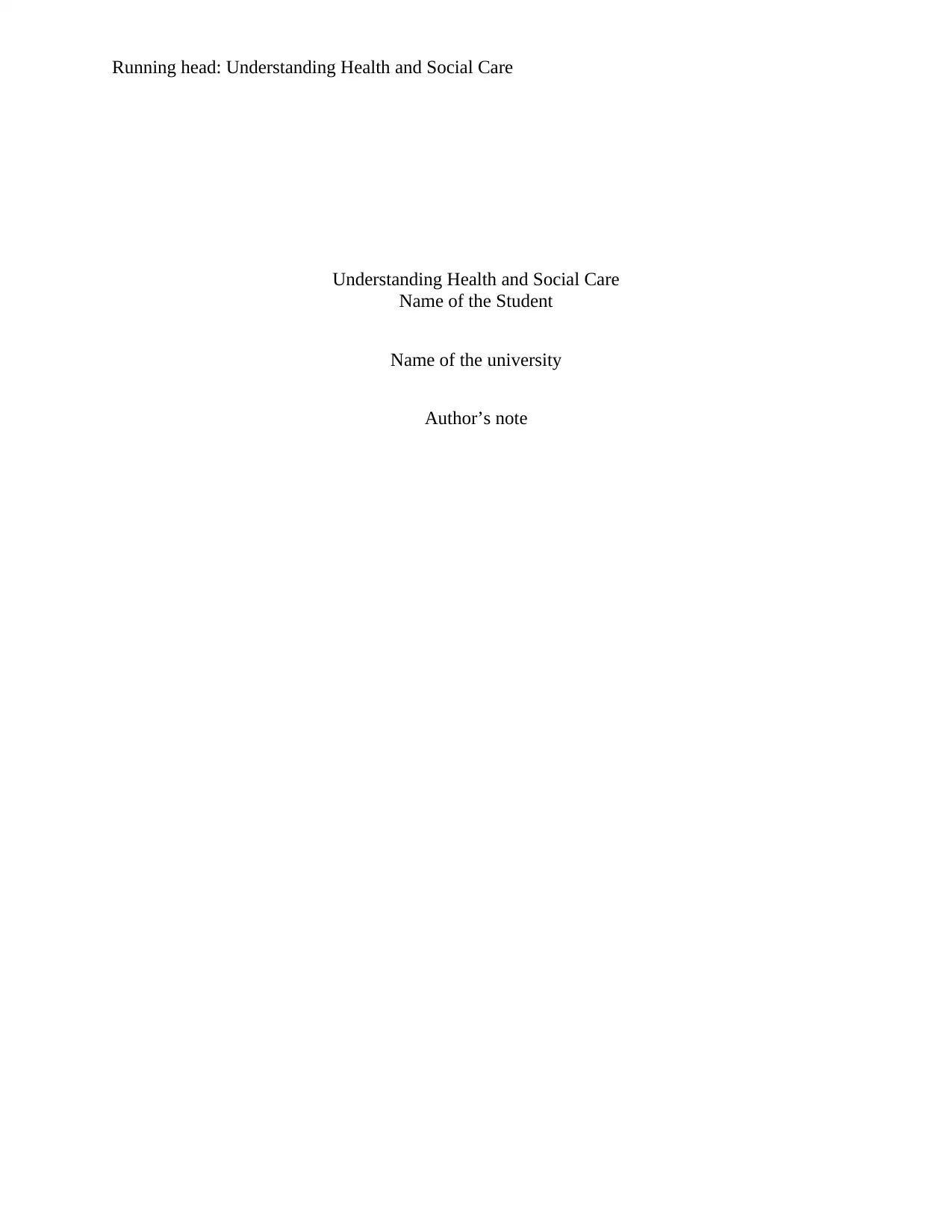
Running head: Understanding Health and Social Care
Understanding Health and Social Care
Name of the Student
Name of the university
Author’s note
Understanding Health and Social Care
Name of the Student
Name of the university
Author’s note
Paraphrase This Document
Need a fresh take? Get an instant paraphrase of this document with our AI Paraphraser
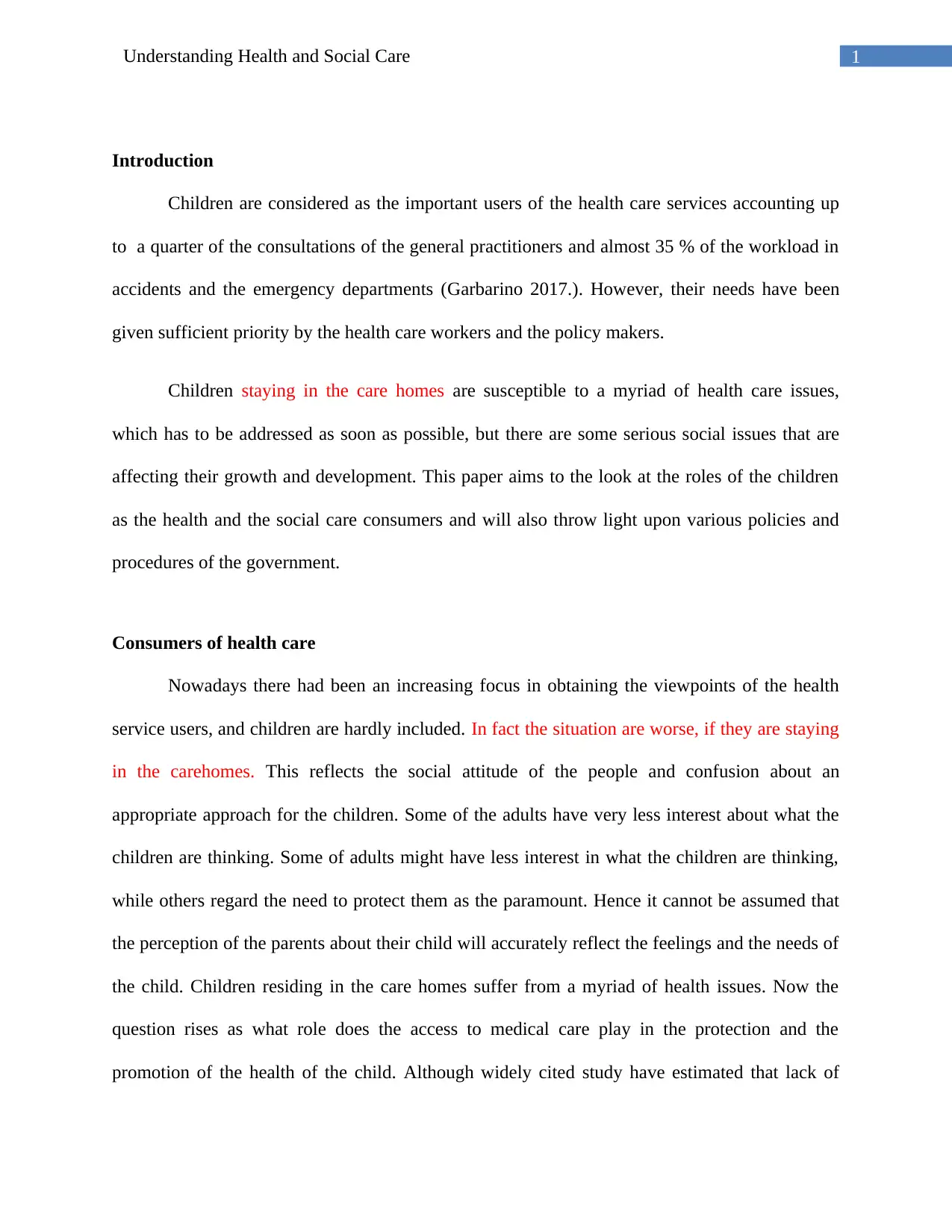
1Understanding Health and Social Care
Introduction
Children are considered as the important users of the health care services accounting up
to a quarter of the consultations of the general practitioners and almost 35 % of the workload in
accidents and the emergency departments (Garbarino 2017.). However, their needs have been
given sufficient priority by the health care workers and the policy makers.
Children staying in the care homes are susceptible to a myriad of health care issues,
which has to be addressed as soon as possible, but there are some serious social issues that are
affecting their growth and development. This paper aims to the look at the roles of the children
as the health and the social care consumers and will also throw light upon various policies and
procedures of the government.
Consumers of health care
Nowadays there had been an increasing focus in obtaining the viewpoints of the health
service users, and children are hardly included. In fact the situation are worse, if they are staying
in the carehomes. This reflects the social attitude of the people and confusion about an
appropriate approach for the children. Some of the adults have very less interest about what the
children are thinking. Some of adults might have less interest in what the children are thinking,
while others regard the need to protect them as the paramount. Hence it cannot be assumed that
the perception of the parents about their child will accurately reflect the feelings and the needs of
the child. Children residing in the care homes suffer from a myriad of health issues. Now the
question rises as what role does the access to medical care play in the protection and the
promotion of the health of the child. Although widely cited study have estimated that lack of
Introduction
Children are considered as the important users of the health care services accounting up
to a quarter of the consultations of the general practitioners and almost 35 % of the workload in
accidents and the emergency departments (Garbarino 2017.). However, their needs have been
given sufficient priority by the health care workers and the policy makers.
Children staying in the care homes are susceptible to a myriad of health care issues,
which has to be addressed as soon as possible, but there are some serious social issues that are
affecting their growth and development. This paper aims to the look at the roles of the children
as the health and the social care consumers and will also throw light upon various policies and
procedures of the government.
Consumers of health care
Nowadays there had been an increasing focus in obtaining the viewpoints of the health
service users, and children are hardly included. In fact the situation are worse, if they are staying
in the carehomes. This reflects the social attitude of the people and confusion about an
appropriate approach for the children. Some of the adults have very less interest about what the
children are thinking. Some of adults might have less interest in what the children are thinking,
while others regard the need to protect them as the paramount. Hence it cannot be assumed that
the perception of the parents about their child will accurately reflect the feelings and the needs of
the child. Children residing in the care homes suffer from a myriad of health issues. Now the
question rises as what role does the access to medical care play in the protection and the
promotion of the health of the child. Although widely cited study have estimated that lack of
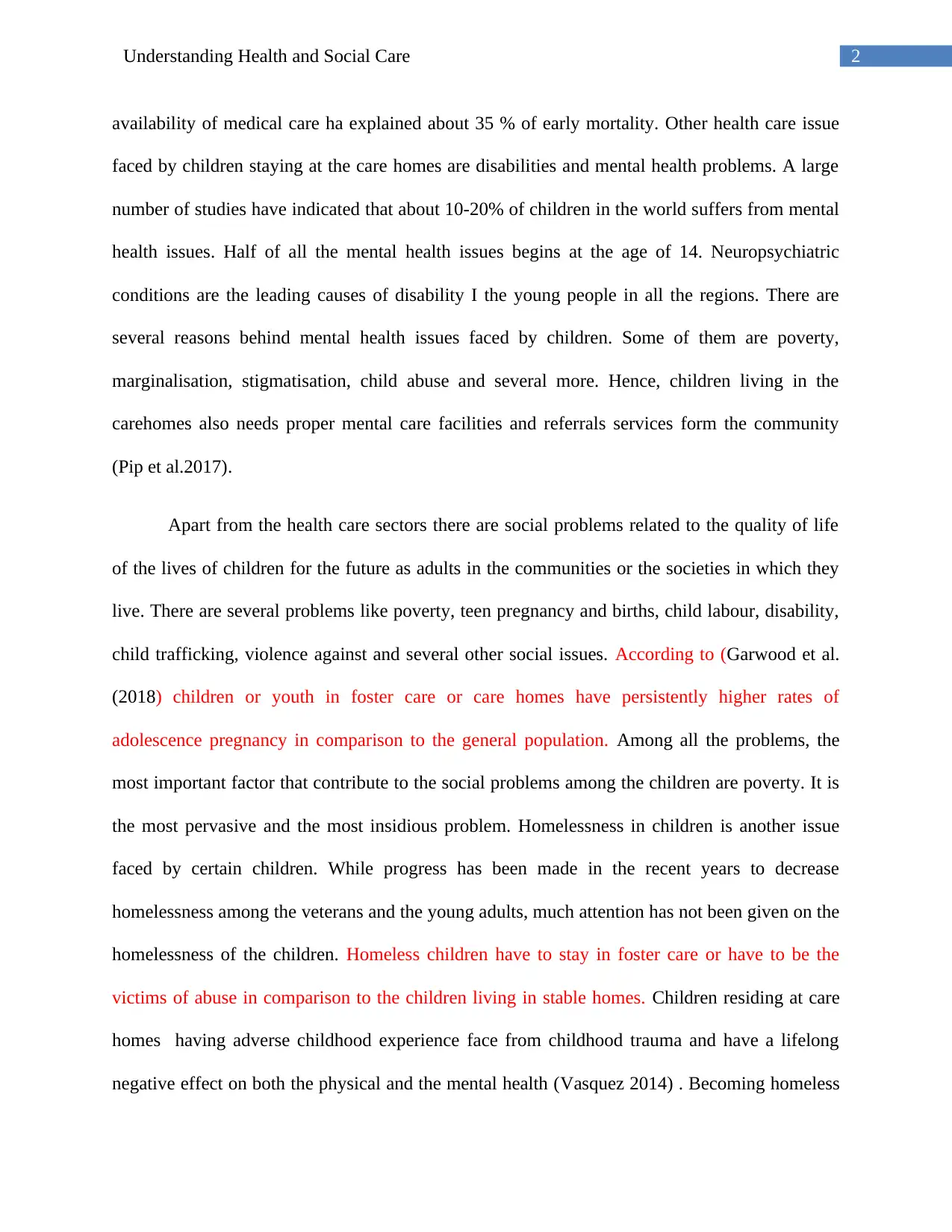
2Understanding Health and Social Care
availability of medical care ha explained about 35 % of early mortality. Other health care issue
faced by children staying at the care homes are disabilities and mental health problems. A large
number of studies have indicated that about 10-20% of children in the world suffers from mental
health issues. Half of all the mental health issues begins at the age of 14. Neuropsychiatric
conditions are the leading causes of disability I the young people in all the regions. There are
several reasons behind mental health issues faced by children. Some of them are poverty,
marginalisation, stigmatisation, child abuse and several more. Hence, children living in the
carehomes also needs proper mental care facilities and referrals services form the community
(Pip et al.2017).
Apart from the health care sectors there are social problems related to the quality of life
of the lives of children for the future as adults in the communities or the societies in which they
live. There are several problems like poverty, teen pregnancy and births, child labour, disability,
child trafficking, violence against and several other social issues. According to (Garwood et al.
(2018) children or youth in foster care or care homes have persistently higher rates of
adolescence pregnancy in comparison to the general population. Among all the problems, the
most important factor that contribute to the social problems among the children are poverty. It is
the most pervasive and the most insidious problem. Homelessness in children is another issue
faced by certain children. While progress has been made in the recent years to decrease
homelessness among the veterans and the young adults, much attention has not been given on the
homelessness of the children. Homeless children have to stay in foster care or have to be the
victims of abuse in comparison to the children living in stable homes. Children residing at care
homes having adverse childhood experience face from childhood trauma and have a lifelong
negative effect on both the physical and the mental health (Vasquez 2014) . Becoming homeless
availability of medical care ha explained about 35 % of early mortality. Other health care issue
faced by children staying at the care homes are disabilities and mental health problems. A large
number of studies have indicated that about 10-20% of children in the world suffers from mental
health issues. Half of all the mental health issues begins at the age of 14. Neuropsychiatric
conditions are the leading causes of disability I the young people in all the regions. There are
several reasons behind mental health issues faced by children. Some of them are poverty,
marginalisation, stigmatisation, child abuse and several more. Hence, children living in the
carehomes also needs proper mental care facilities and referrals services form the community
(Pip et al.2017).
Apart from the health care sectors there are social problems related to the quality of life
of the lives of children for the future as adults in the communities or the societies in which they
live. There are several problems like poverty, teen pregnancy and births, child labour, disability,
child trafficking, violence against and several other social issues. According to (Garwood et al.
(2018) children or youth in foster care or care homes have persistently higher rates of
adolescence pregnancy in comparison to the general population. Among all the problems, the
most important factor that contribute to the social problems among the children are poverty. It is
the most pervasive and the most insidious problem. Homelessness in children is another issue
faced by certain children. While progress has been made in the recent years to decrease
homelessness among the veterans and the young adults, much attention has not been given on the
homelessness of the children. Homeless children have to stay in foster care or have to be the
victims of abuse in comparison to the children living in stable homes. Children residing at care
homes having adverse childhood experience face from childhood trauma and have a lifelong
negative effect on both the physical and the mental health (Vasquez 2014) . Becoming homeless
⊘ This is a preview!⊘
Do you want full access?
Subscribe today to unlock all pages.

Trusted by 1+ million students worldwide
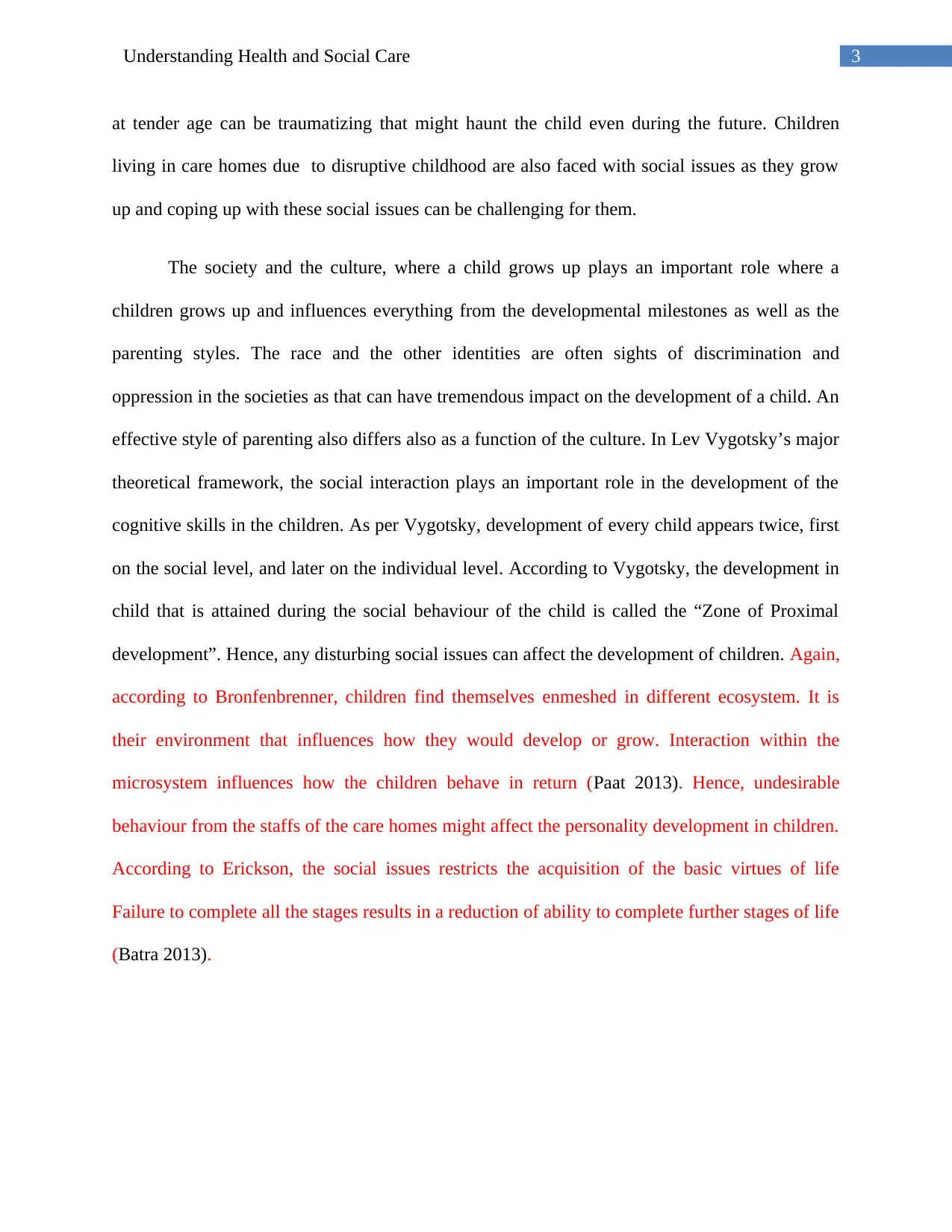
3Understanding Health and Social Care
at tender age can be traumatizing that might haunt the child even during the future. Children
living in care homes due to disruptive childhood are also faced with social issues as they grow
up and coping up with these social issues can be challenging for them.
The society and the culture, where a child grows up plays an important role where a
children grows up and influences everything from the developmental milestones as well as the
parenting styles. The race and the other identities are often sights of discrimination and
oppression in the societies as that can have tremendous impact on the development of a child. An
effective style of parenting also differs also as a function of the culture. In Lev Vygotsky’s major
theoretical framework, the social interaction plays an important role in the development of the
cognitive skills in the children. As per Vygotsky, development of every child appears twice, first
on the social level, and later on the individual level. According to Vygotsky, the development in
child that is attained during the social behaviour of the child is called the “Zone of Proximal
development”. Hence, any disturbing social issues can affect the development of children. Again,
according to Bronfenbrenner, children find themselves enmeshed in different ecosystem. It is
their environment that influences how they would develop or grow. Interaction within the
microsystem influences how the children behave in return (Paat 2013). Hence, undesirable
behaviour from the staffs of the care homes might affect the personality development in children.
According to Erickson, the social issues restricts the acquisition of the basic virtues of life
Failure to complete all the stages results in a reduction of ability to complete further stages of life
(Batra 2013).
at tender age can be traumatizing that might haunt the child even during the future. Children
living in care homes due to disruptive childhood are also faced with social issues as they grow
up and coping up with these social issues can be challenging for them.
The society and the culture, where a child grows up plays an important role where a
children grows up and influences everything from the developmental milestones as well as the
parenting styles. The race and the other identities are often sights of discrimination and
oppression in the societies as that can have tremendous impact on the development of a child. An
effective style of parenting also differs also as a function of the culture. In Lev Vygotsky’s major
theoretical framework, the social interaction plays an important role in the development of the
cognitive skills in the children. As per Vygotsky, development of every child appears twice, first
on the social level, and later on the individual level. According to Vygotsky, the development in
child that is attained during the social behaviour of the child is called the “Zone of Proximal
development”. Hence, any disturbing social issues can affect the development of children. Again,
according to Bronfenbrenner, children find themselves enmeshed in different ecosystem. It is
their environment that influences how they would develop or grow. Interaction within the
microsystem influences how the children behave in return (Paat 2013). Hence, undesirable
behaviour from the staffs of the care homes might affect the personality development in children.
According to Erickson, the social issues restricts the acquisition of the basic virtues of life
Failure to complete all the stages results in a reduction of ability to complete further stages of life
(Batra 2013).
Paraphrase This Document
Need a fresh take? Get an instant paraphrase of this document with our AI Paraphraser
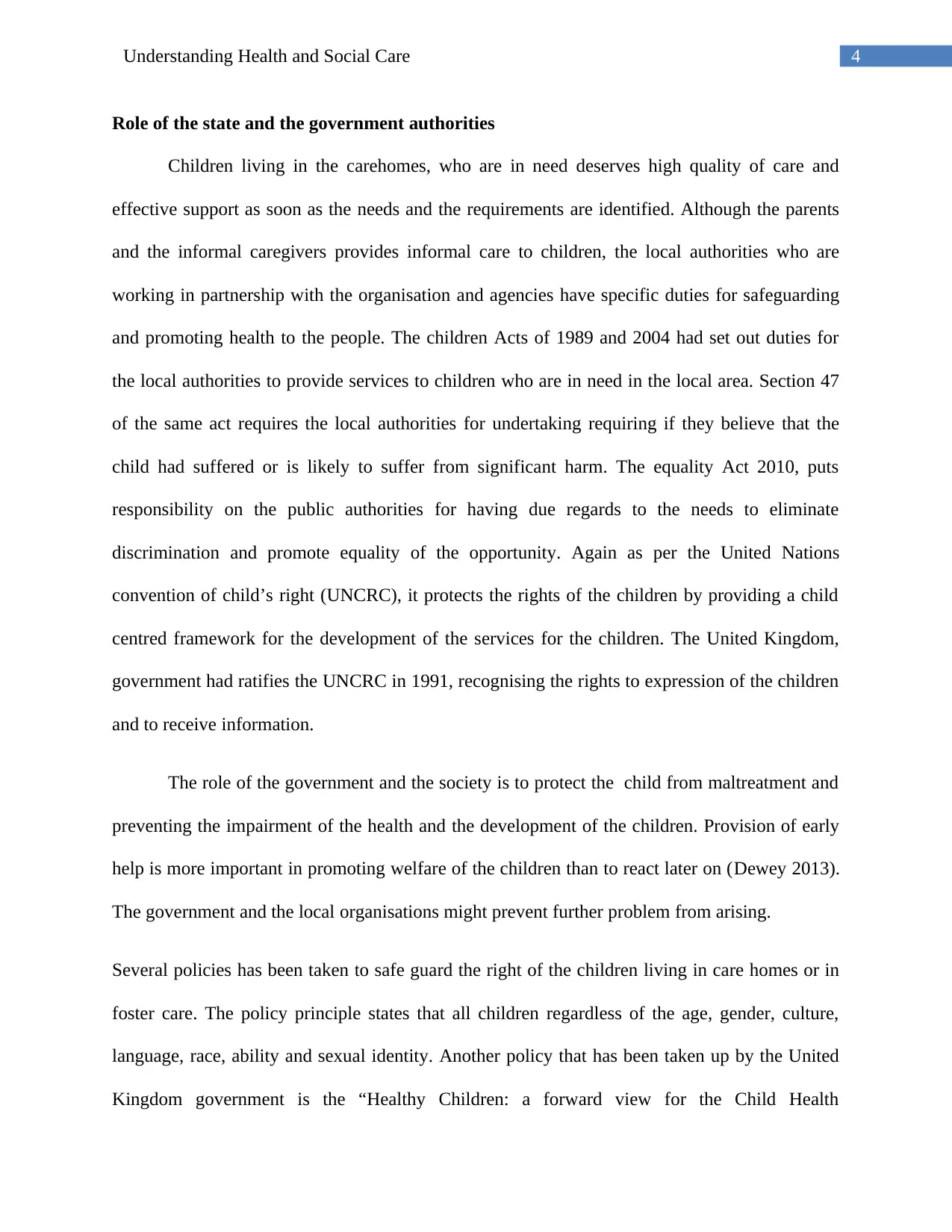
4Understanding Health and Social Care
Role of the state and the government authorities
Children living in the carehomes, who are in need deserves high quality of care and
effective support as soon as the needs and the requirements are identified. Although the parents
and the informal caregivers provides informal care to children, the local authorities who are
working in partnership with the organisation and agencies have specific duties for safeguarding
and promoting health to the people. The children Acts of 1989 and 2004 had set out duties for
the local authorities to provide services to children who are in need in the local area. Section 47
of the same act requires the local authorities for undertaking requiring if they believe that the
child had suffered or is likely to suffer from significant harm. The equality Act 2010, puts
responsibility on the public authorities for having due regards to the needs to eliminate
discrimination and promote equality of the opportunity. Again as per the United Nations
convention of child’s right (UNCRC), it protects the rights of the children by providing a child
centred framework for the development of the services for the children. The United Kingdom,
government had ratifies the UNCRC in 1991, recognising the rights to expression of the children
and to receive information.
The role of the government and the society is to protect the child from maltreatment and
preventing the impairment of the health and the development of the children. Provision of early
help is more important in promoting welfare of the children than to react later on (Dewey 2013).
The government and the local organisations might prevent further problem from arising.
Several policies has been taken to safe guard the right of the children living in care homes or in
foster care. The policy principle states that all children regardless of the age, gender, culture,
language, race, ability and sexual identity. Another policy that has been taken up by the United
Kingdom government is the “Healthy Children: a forward view for the Child Health
Role of the state and the government authorities
Children living in the carehomes, who are in need deserves high quality of care and
effective support as soon as the needs and the requirements are identified. Although the parents
and the informal caregivers provides informal care to children, the local authorities who are
working in partnership with the organisation and agencies have specific duties for safeguarding
and promoting health to the people. The children Acts of 1989 and 2004 had set out duties for
the local authorities to provide services to children who are in need in the local area. Section 47
of the same act requires the local authorities for undertaking requiring if they believe that the
child had suffered or is likely to suffer from significant harm. The equality Act 2010, puts
responsibility on the public authorities for having due regards to the needs to eliminate
discrimination and promote equality of the opportunity. Again as per the United Nations
convention of child’s right (UNCRC), it protects the rights of the children by providing a child
centred framework for the development of the services for the children. The United Kingdom,
government had ratifies the UNCRC in 1991, recognising the rights to expression of the children
and to receive information.
The role of the government and the society is to protect the child from maltreatment and
preventing the impairment of the health and the development of the children. Provision of early
help is more important in promoting welfare of the children than to react later on (Dewey 2013).
The government and the local organisations might prevent further problem from arising.
Several policies has been taken to safe guard the right of the children living in care homes or in
foster care. The policy principle states that all children regardless of the age, gender, culture,
language, race, ability and sexual identity. Another policy that has been taken up by the United
Kingdom government is the “Healthy Children: a forward view for the Child Health
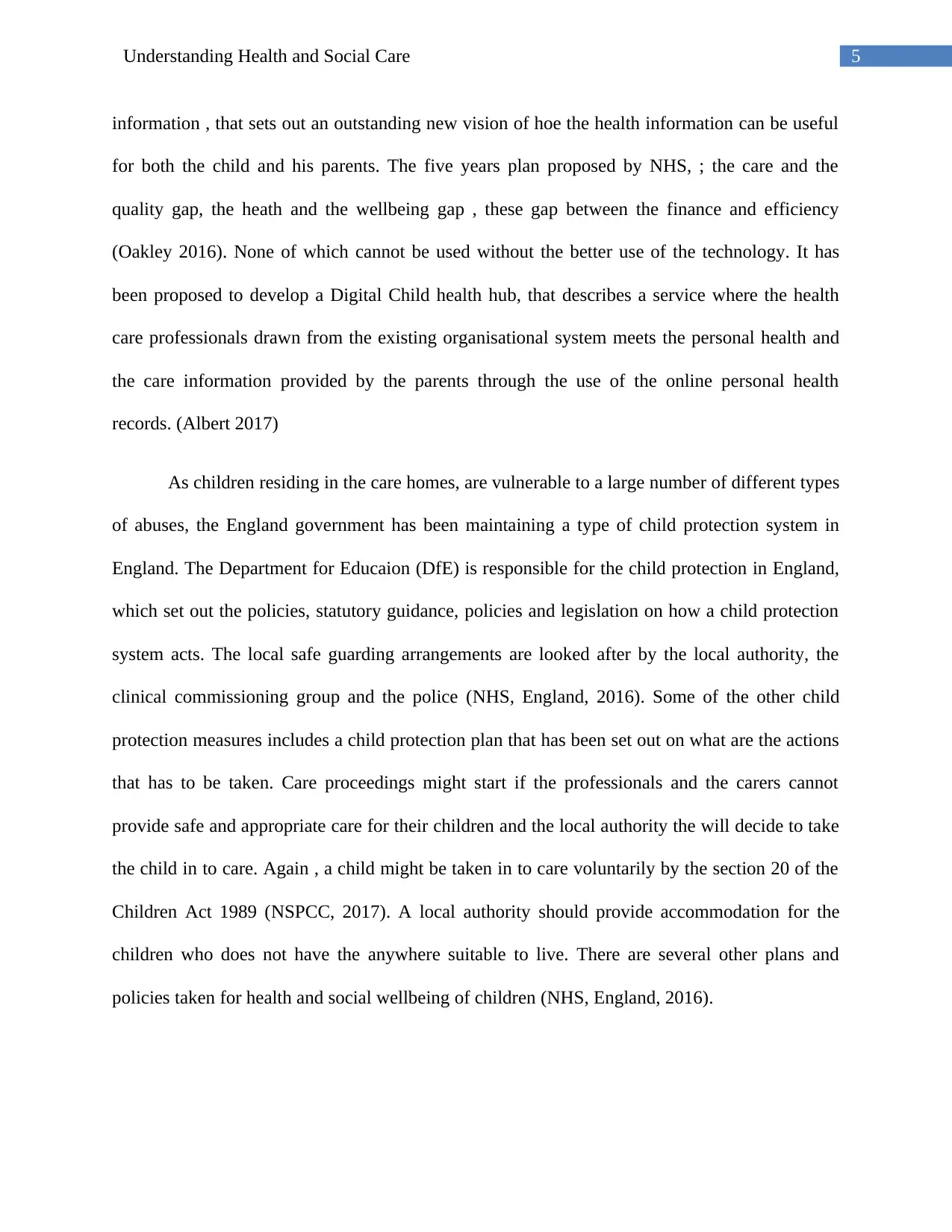
5Understanding Health and Social Care
information , that sets out an outstanding new vision of hoe the health information can be useful
for both the child and his parents. The five years plan proposed by NHS, ; the care and the
quality gap, the heath and the wellbeing gap , these gap between the finance and efficiency
(Oakley 2016). None of which cannot be used without the better use of the technology. It has
been proposed to develop a Digital Child health hub, that describes a service where the health
care professionals drawn from the existing organisational system meets the personal health and
the care information provided by the parents through the use of the online personal health
records. (Albert 2017)
As children residing in the care homes, are vulnerable to a large number of different types
of abuses, the England government has been maintaining a type of child protection system in
England. The Department for Educaion (DfE) is responsible for the child protection in England,
which set out the policies, statutory guidance, policies and legislation on how a child protection
system acts. The local safe guarding arrangements are looked after by the local authority, the
clinical commissioning group and the police (NHS, England, 2016). Some of the other child
protection measures includes a child protection plan that has been set out on what are the actions
that has to be taken. Care proceedings might start if the professionals and the carers cannot
provide safe and appropriate care for their children and the local authority the will decide to take
the child in to care. Again , a child might be taken in to care voluntarily by the section 20 of the
Children Act 1989 (NSPCC, 2017). A local authority should provide accommodation for the
children who does not have the anywhere suitable to live. There are several other plans and
policies taken for health and social wellbeing of children (NHS, England, 2016).
information , that sets out an outstanding new vision of hoe the health information can be useful
for both the child and his parents. The five years plan proposed by NHS, ; the care and the
quality gap, the heath and the wellbeing gap , these gap between the finance and efficiency
(Oakley 2016). None of which cannot be used without the better use of the technology. It has
been proposed to develop a Digital Child health hub, that describes a service where the health
care professionals drawn from the existing organisational system meets the personal health and
the care information provided by the parents through the use of the online personal health
records. (Albert 2017)
As children residing in the care homes, are vulnerable to a large number of different types
of abuses, the England government has been maintaining a type of child protection system in
England. The Department for Educaion (DfE) is responsible for the child protection in England,
which set out the policies, statutory guidance, policies and legislation on how a child protection
system acts. The local safe guarding arrangements are looked after by the local authority, the
clinical commissioning group and the police (NHS, England, 2016). Some of the other child
protection measures includes a child protection plan that has been set out on what are the actions
that has to be taken. Care proceedings might start if the professionals and the carers cannot
provide safe and appropriate care for their children and the local authority the will decide to take
the child in to care. Again , a child might be taken in to care voluntarily by the section 20 of the
Children Act 1989 (NSPCC, 2017). A local authority should provide accommodation for the
children who does not have the anywhere suitable to live. There are several other plans and
policies taken for health and social wellbeing of children (NHS, England, 2016).
⊘ This is a preview!⊘
Do you want full access?
Subscribe today to unlock all pages.

Trusted by 1+ million students worldwide
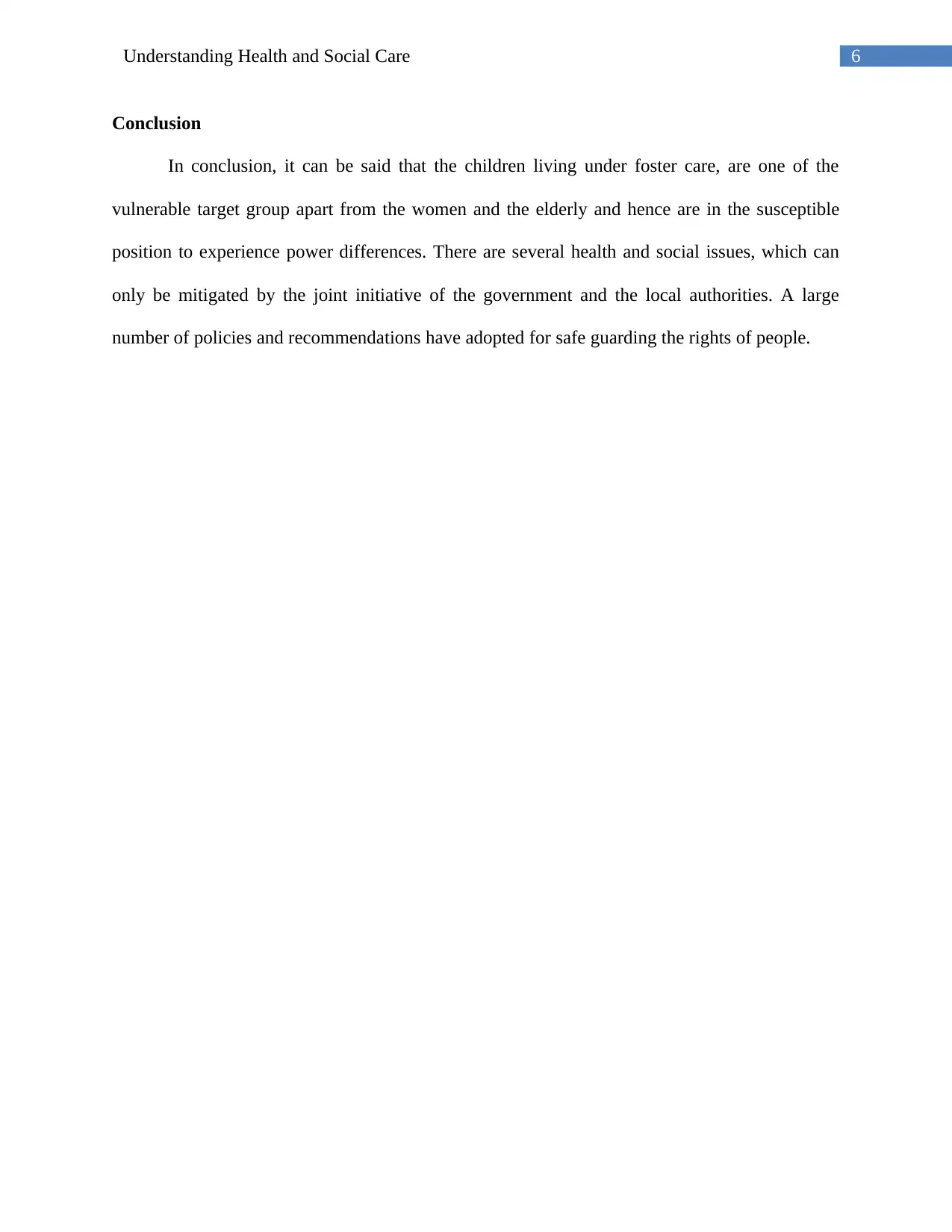
6Understanding Health and Social Care
Conclusion
In conclusion, it can be said that the children living under foster care, are one of the
vulnerable target group apart from the women and the elderly and hence are in the susceptible
position to experience power differences. There are several health and social issues, which can
only be mitigated by the joint initiative of the government and the local authorities. A large
number of policies and recommendations have adopted for safe guarding the rights of people.
Conclusion
In conclusion, it can be said that the children living under foster care, are one of the
vulnerable target group apart from the women and the elderly and hence are in the susceptible
position to experience power differences. There are several health and social issues, which can
only be mitigated by the joint initiative of the government and the local authorities. A large
number of policies and recommendations have adopted for safe guarding the rights of people.
Paraphrase This Document
Need a fresh take? Get an instant paraphrase of this document with our AI Paraphraser
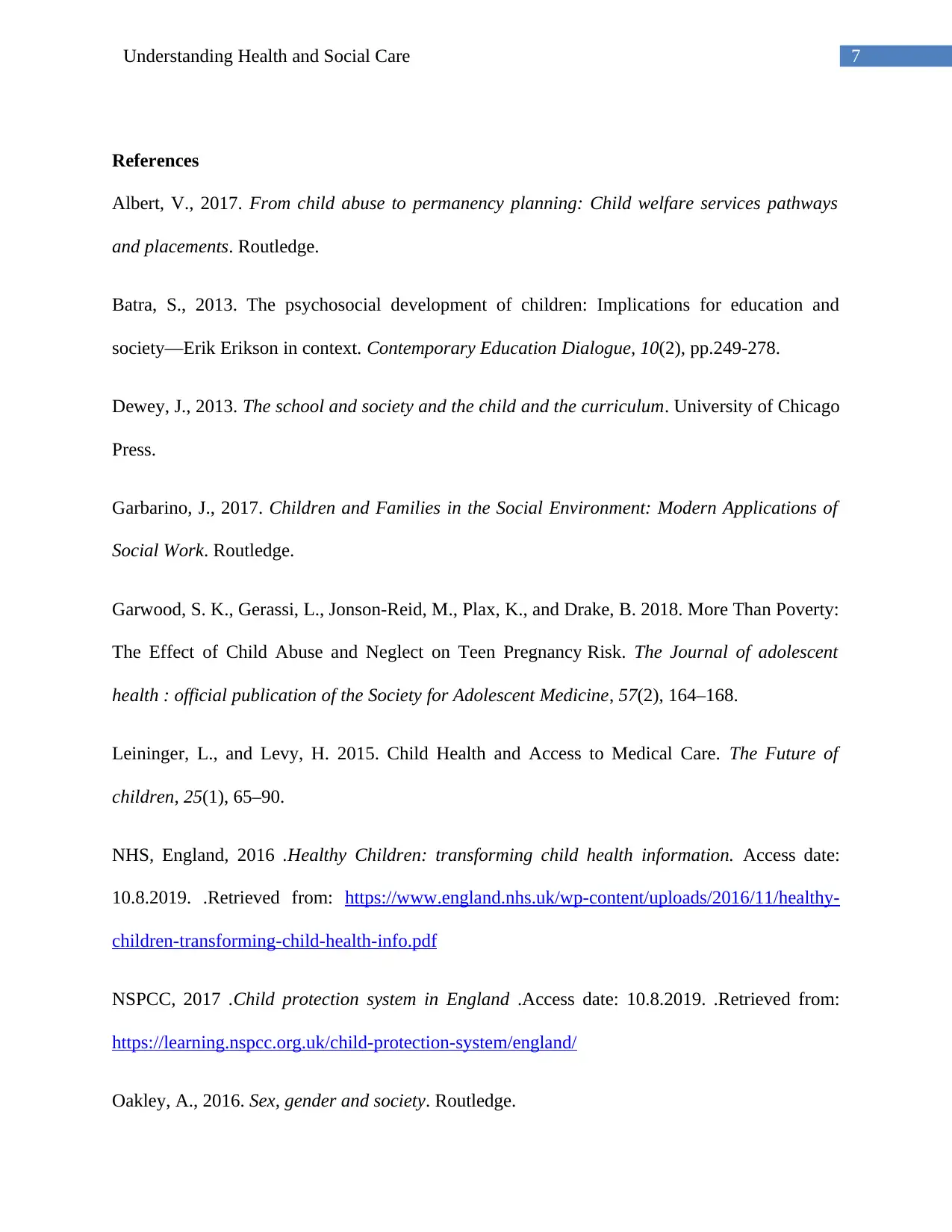
7Understanding Health and Social Care
References
Albert, V., 2017. From child abuse to permanency planning: Child welfare services pathways
and placements. Routledge.
Batra, S., 2013. The psychosocial development of children: Implications for education and
society—Erik Erikson in context. Contemporary Education Dialogue, 10(2), pp.249-278.
Dewey, J., 2013. The school and society and the child and the curriculum. University of Chicago
Press.
Garbarino, J., 2017. Children and Families in the Social Environment: Modern Applications of
Social Work. Routledge.
Garwood, S. K., Gerassi, L., Jonson-Reid, M., Plax, K., and Drake, B. 2018. More Than Poverty:
The Effect of Child Abuse and Neglect on Teen Pregnancy Risk. The Journal of adolescent
health : official publication of the Society for Adolescent Medicine, 57(2), 164–168.
Leininger, L., and Levy, H. 2015. Child Health and Access to Medical Care. The Future of
children, 25(1), 65–90.
NHS, England, 2016 .Healthy Children: transforming child health information. Access date:
10.8.2019. .Retrieved from: https://www.england.nhs.uk/wp-content/uploads/2016/11/healthy-
children-transforming-child-health-info.pdf
NSPCC, 2017 .Child protection system in England .Access date: 10.8.2019. .Retrieved from:
https://learning.nspcc.org.uk/child-protection-system/england/
Oakley, A., 2016. Sex, gender and society. Routledge.
References
Albert, V., 2017. From child abuse to permanency planning: Child welfare services pathways
and placements. Routledge.
Batra, S., 2013. The psychosocial development of children: Implications for education and
society—Erik Erikson in context. Contemporary Education Dialogue, 10(2), pp.249-278.
Dewey, J., 2013. The school and society and the child and the curriculum. University of Chicago
Press.
Garbarino, J., 2017. Children and Families in the Social Environment: Modern Applications of
Social Work. Routledge.
Garwood, S. K., Gerassi, L., Jonson-Reid, M., Plax, K., and Drake, B. 2018. More Than Poverty:
The Effect of Child Abuse and Neglect on Teen Pregnancy Risk. The Journal of adolescent
health : official publication of the Society for Adolescent Medicine, 57(2), 164–168.
Leininger, L., and Levy, H. 2015. Child Health and Access to Medical Care. The Future of
children, 25(1), 65–90.
NHS, England, 2016 .Healthy Children: transforming child health information. Access date:
10.8.2019. .Retrieved from: https://www.england.nhs.uk/wp-content/uploads/2016/11/healthy-
children-transforming-child-health-info.pdf
NSPCC, 2017 .Child protection system in England .Access date: 10.8.2019. .Retrieved from:
https://learning.nspcc.org.uk/child-protection-system/england/
Oakley, A., 2016. Sex, gender and society. Routledge.
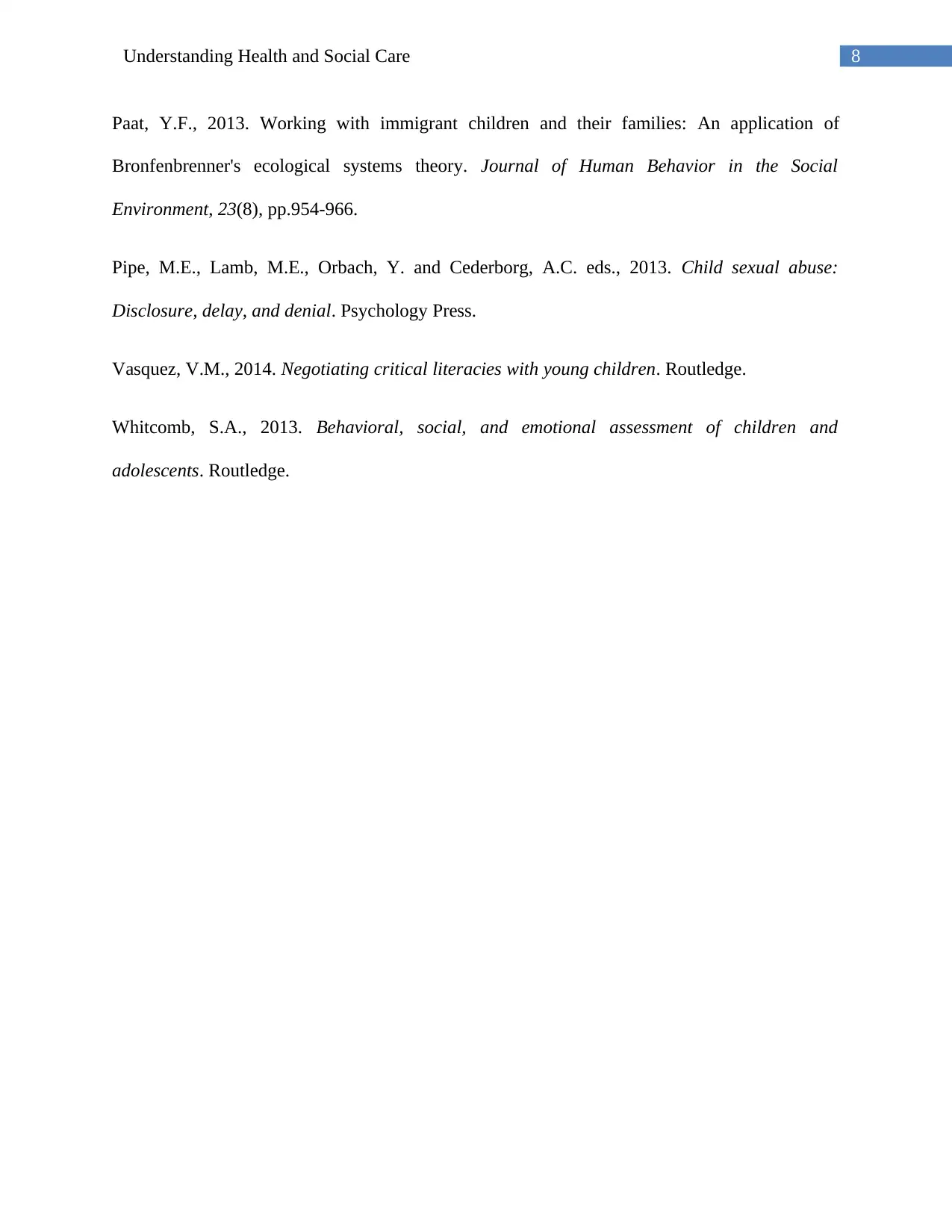
8Understanding Health and Social Care
Paat, Y.F., 2013. Working with immigrant children and their families: An application of
Bronfenbrenner's ecological systems theory. Journal of Human Behavior in the Social
Environment, 23(8), pp.954-966.
Pipe, M.E., Lamb, M.E., Orbach, Y. and Cederborg, A.C. eds., 2013. Child sexual abuse:
Disclosure, delay, and denial. Psychology Press.
Vasquez, V.M., 2014. Negotiating critical literacies with young children. Routledge.
Whitcomb, S.A., 2013. Behavioral, social, and emotional assessment of children and
adolescents. Routledge.
Paat, Y.F., 2013. Working with immigrant children and their families: An application of
Bronfenbrenner's ecological systems theory. Journal of Human Behavior in the Social
Environment, 23(8), pp.954-966.
Pipe, M.E., Lamb, M.E., Orbach, Y. and Cederborg, A.C. eds., 2013. Child sexual abuse:
Disclosure, delay, and denial. Psychology Press.
Vasquez, V.M., 2014. Negotiating critical literacies with young children. Routledge.
Whitcomb, S.A., 2013. Behavioral, social, and emotional assessment of children and
adolescents. Routledge.
⊘ This is a preview!⊘
Do you want full access?
Subscribe today to unlock all pages.

Trusted by 1+ million students worldwide
1 out of 9
Related Documents
Your All-in-One AI-Powered Toolkit for Academic Success.
+13062052269
info@desklib.com
Available 24*7 on WhatsApp / Email
![[object Object]](/_next/static/media/star-bottom.7253800d.svg)
Unlock your academic potential
Copyright © 2020–2025 A2Z Services. All Rights Reserved. Developed and managed by ZUCOL.





